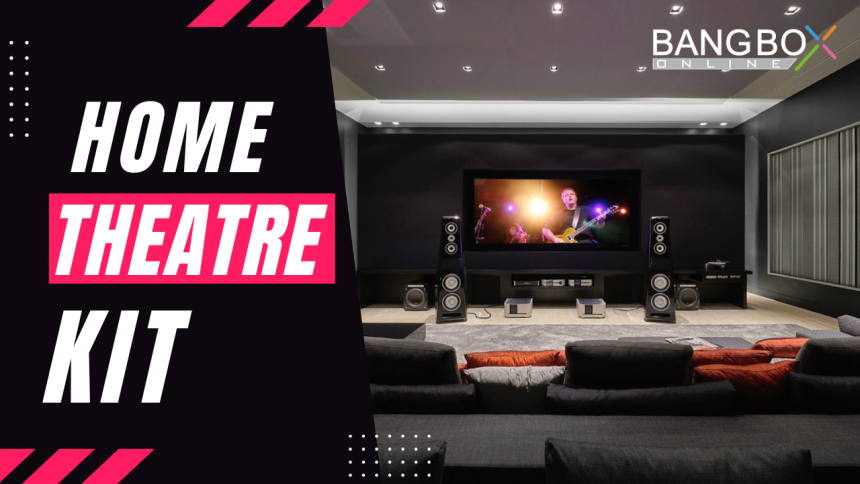
Creating the Ultimate Home Theatre Experience: Home Theatre kit
Incorporating a well-chosen home theatre kit into your entertainment space can transform ordinary movie nights into extraordinary cinematic experiences, bringing the magic of the big screen right to your doorstep.
It’s undeniable, there is something about watching movies in the comfort of your own home. The right home theatre package can turn your home into a filmaholic heaven. This article will unravel the mysteries of home theatre kits. what you might expect from a home theatre system setup, the kinds of kits available, their costs, and hints to construct a dedicated home theatre room. So, let’s start going through all the options for creating the perfect home movie theatre experience.
Home Theatre Set Up: A Visual and Auditory Pleasure
Having a huge TV or a projector is not enough for a home theatre system set up. It is a cross-media production consisting of sound and image components planned to create an immersive visual and auditory impression. Here are the key elements of a home theatre design:
1. Display:
The display options you could choose are either a high-definition TV or a projector with a screen. When choosing a projector, think about things such as screen size, resolution, and display technology (LCD, OLED, DLP).
2. Audio:
A home theatre speaker package is crucial to have immersive audio. Generally speaking, surround sound systems include two main channels to the front and two to the backsides with subwoofers, along with some height or overhead speakers for a more advanced approach with Dolby Atmos.
3. Receiver:
At the core of your home theatre system is a receiver or an AV receiver. A central control unit that ties your different audio and video sources together. It is important when changing input sources, decoding audio formats, and indeed powering your speakers.
4. Source Devices:
Devices you may be including Blu-ray Players, Streaming Devices, Game Consoles, and Cable/Satellite Boxes. Make sure your receiver can accept all of your source units with its available HDMI inputs.
5. Cables and Wiring:
To deliver the best sound quality, you need top-notch HDMI cords and speaker cords. Good cable management keeps things neat.
6. Furniture and Seating:
A comfortable design with well-chosen furniture can improve not only how good your home theatre looks but also feel.
Types of Home Theatre Kits
When it comes to home theatre kits, you have several options to choose from based on your budget and preferences:
1. All-in-One Home Theatre Kits:
All these kits include a TV or Projector + Speakers and a Receiver you’ll need to have a home theatre set up. They are easy for beginners but might not be able to provide you with the highest level of personalization or audio sound.
2. Soundbar Kits:
Surround sound systems in TV are expensive but an investment in future-proofing could be the right decision for you. Or even better. An investment in a soundbar at less than half the cost of a built-in surround system could be the best compromise. In the box, you get a wireless subwoofer if you’re lucky enough to have the appropriate kit to take full advantage! They deliver an affordable and big sound improvement over TV speakers, but they don’t deliver the full theatre at-home feeling.
3. Home Theatre Board Kit:
If you want something even more personalized, there is also a Board Kit where you can pick out the receiver, speakers, and screen individually. It provides you with more flexibility regarding the quality and features of each unit.
4. Wireless Home Theatre Kits:
Wireless technology, which allows for easy connection between the speaker and the receiver without much complicated wiring. It’s perfect if you prefer a minimalist and organized environment.
Home Theatre Kit Price: What to Expect
The price of a home theatre setup cost will depend on several criteria including brand, quality, and what components are available. Here's a general price range breakdown:
All-in-One Kits:
Some of the cheapest entry-level models begin at about $300 – $500 while more advanced models can cost over $1,000, even upwards of $2,000.
Soundbar Kits: Basic soundbars start at around $100 going up to expensive ones which would be around $500–$1,500.
Component Kits:
Kits present the most amount of flexibility but could also potentially hold the most elevated cost. Predict pricing for a complete system to fall within a range of $1,000-$5,000 or higher based on the components chosen.
Home Theatre Bluetooth kit:
Bluetooth Home theatre Kits fall in the $500 — $2,000 price range, which is more expensive than portable alternatives, although there are many options available at different price points depending on brand and specifications.
Remember that you can always buy lower-cost versions but typically upgrading the components will give your home theatre better overall results in audio/video performance.
How to build a home theatre room?
If you’re serious about really getting fully covered in home theatre, then build yourself a proper home theatre room. Here are steps to help you get started:
1. Choose the Right Space:
Choose a space without much sunlight and good soundproofing. people are typically the perfect place to do this (basements).
2. Plan the Layout:
Decide how many people will fill each row, where to arrange the theatre seating, whether to use screens or projectors, and how to place the speakers according to your chosen setup. Talk to an expert to find out the best way to distribute sound and video.
3. Auditory Treatment:
Look at home theatre speaker sets, such as soundproofing or auditory panels, and bass traps for improving the sound quality, and eliminating outside noise disturbance.
4. Light Control:
Blackout curtains or blinds can help regulate external light so you achieve optimum image quality.
5. Electrical and Wiring:
Check that you have enough electrical outlets and wiring in the room for your setup.
6. Decoration and Comfort:
Pick out comfy furniture, decorate the area with what you love, and smarten up the place with pieces of yourself that will make it feel like home.
7. Calibration:
With all that set up, configure audio and video components for the most optimal performance.
Conclusion
With the perfect home theatre kit, you will be enjoying cinematic viewing with the best visuals and sound. If you go the all-in-one route, that is great and if you choose more of a custom build approach, pick what fits within your budget, desired aesthetics, and given space. (And if you’re really into home theatre, give over a whole room for your dream home cinema.)



We are a skilled team of developers
We are a skilled team of developers, designers, and strategists dedicated to creating inno...
